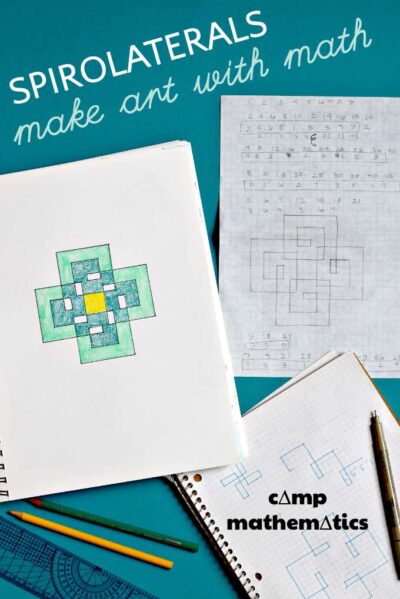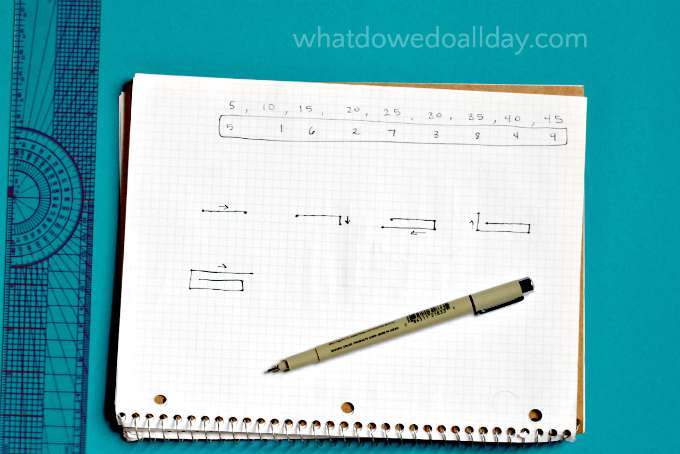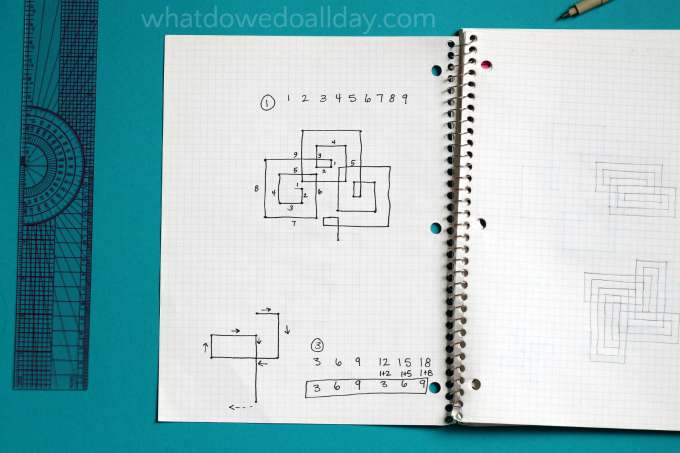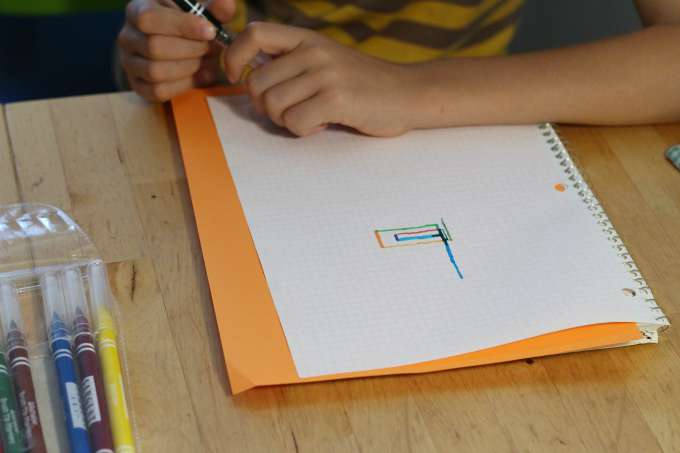We are working on patterning and math art this week for Camp Mathematics. Have you ever heard of spirolaterals? Yeah, me neither. I happened upon them while looking for a new math art project to inspire my kids. If you follow this blog (hugs and kisses for you) then you are aware of my great love of using my kids' natural interest in math to encourage them to make art.

The great thing about spirolaterals is that not only are they gorgeous but in the process of making them, kids who love numbers can work on their skip counting and multiplication skills. Creating spirolateral math art also involves graphing and patterning so there is a whole host of awesome math and art integration going on.
Let's get down to business, shall we?
What are Spirolaterals?
Very simply, spirolaterals are spiraled, structured designs based on a repeated series of commands using length and angle.
Clear as mud?
The way I explained it to my son is that, "we would use the times tables to create spirals."
Spirolaterals can range from very basic to elaborate, depending on the angle and number patterns used. The simplest type of spirolateral is a square -- a 90 degree angle turn with a 1,1,1,1 sequence. (See some more complex patterns here.) It sounds complicated, but once you understand what's going on, it's very easy and fun to do.
Watch the grooviness and then get the full instructions below:
Choose a number and write its multiplication sequence. I'll use 5 as an example.
5, 10, 15, 20, 25, 30, 35, 40, 45, 50, 55
Now, turn it into a sequence of single digits by adding the two digits of each number together. For example 10 becomes 1+0=1, 1+5=6 and so forth.
5, 1, 6, 2, 7, 3, 8, 4, 9, 5, 1
Once you see the pattern start to repeat you can stop. So we would be left with 5, 1, 6, 2, 7, 3, 8, 4, 9 as our final sequence.

Now you are ready to draw!
- Get your graph paper.
- Draw a line 5 squares long.
- Make a 90 degree turn to the right.
- Draw a line 1 square long.
- Make a 90 degree turn to the right.
- Draw a line 6 squares long.
- See the pattern?
- When you complete the final line in your sequence, start over with the first number.
- Repeat until the spirals connect back to the very first line.
Here's how to get started with multiples of 1:

TIPS:
- With younger children, start with the sequence 1, 2, 3, 4, 5, 6, 7, 8, 9.
- Some of the numbers make very large spirals. Graph paper with more squares per inch is better.
EXTENSIONS:
- Compare the patterns of different sequences. Do some of them look similar?
- Color in your spirolateral to make it snazzy.
- Advanced kids can try 45 degree angles instead of 90 degree.
- You don't have to use times tables, what other number patterns can you use?
All the photos of my son working on this came out lousy since we did it in the evening, but he had the cool idea to make each line a different color.

MORE: Be inspired with our favorite math art projects.
Now it's time to head over to Coffee Cups and Crayons to see how Megan and her kids explored patterns in nature!
MORE: Favorite math art books
Previous Camp Mathematics activities:
Week 1: Counting Down Game and DIY Abacus
Week 2: Magic Squares and Shake and Roll Math Game
Week 3: T Puzzle brain teaser and Grape Shapes






Olavi says
Wow, nice blog!
My wife doing something similar like you!
Blogging things what do with kids 🙂
Take a look, maybe you get some inspiriaton like we get reading your blog 🙂
http://gladkid.com
Jamey says
You should check out Usborne's new "This is Not a Math Book". It's full of math-art projects. I'm not mathy or artistic (unlike my son who is both!) and we're both loving it!
Lisa M says
I love the new "This is not a Math Book." You can check it out here if you like.
Lisa M says
http://www.Lisasbookshop.com
Erica MomandKiddo says
Thanks Lisa! My friend sells Usborne, so I got it from her. 🙂
pt says
Hi- fyi, getting an error when I clicked the Subscribe button...
Michelle says
That is A-Mazing! I'd never heard of spirolaterals before, but I totally can't wait to try this. So glad I have graph paper!
Erica MomandKiddo says
Thanks, Michelle! I hope you enjoy it.
John Golden says
Thanks for reminding me of these. I made a little interactive to help explore them: http://tube.geogebra.org/m/1471545
Do you have a source for where you first saw them? I can't place it.
Erica MomandKiddo says
I found them first in a math book called "Math Projects for Kids" but I've seen them in other math books too.
suret kamstra says
love it
Tamara Kula says
Wow! I never heard about that before. My boys (11 and 7) love spirographs and graph paper both, so this looks perfect. I will definitely do this with them. 🙂 Thanks!
Erica says
Enjoy! I hope they like it!
Beverley says
Use this website (or another similar one) to generate your own graph paper.... https://incompetech.com/graphpaper/plain/ (It's not my website)
Wei-Ling Chu says
I am doing this with my students, and was just trying the numbers it seems that 7, 4, 8 did not have a terminating pattern, even when I go into the 3 digit multiplication result. Thoughts? Thanks!
Jo says
Sorry if this is too late for you but if you make 10 your biggest number and keep adding the 2 numbers together for numbes bigger than 10 you will get a repetition. (So for example if you are at 11x7=77. 7+7=14. 1+4=5).
Chelsie says
Hey this is super cool. Thanks for sharing!
Rei says
This sounds fun, i'm gonna use it in my class, thanks for sharing!
Erica says
Enjoy!